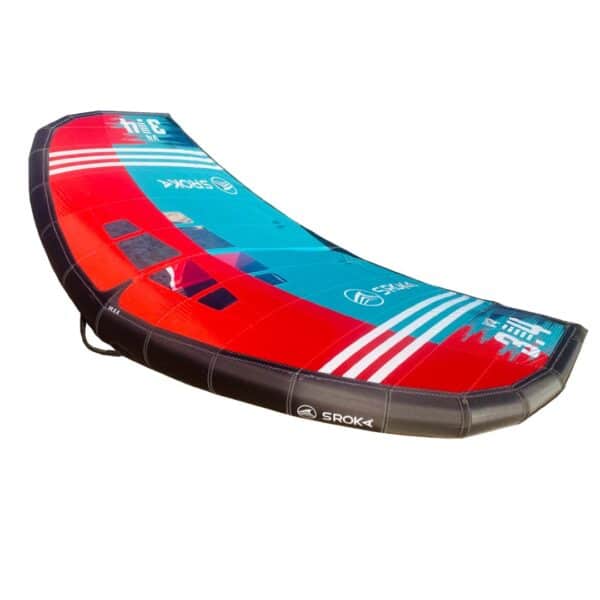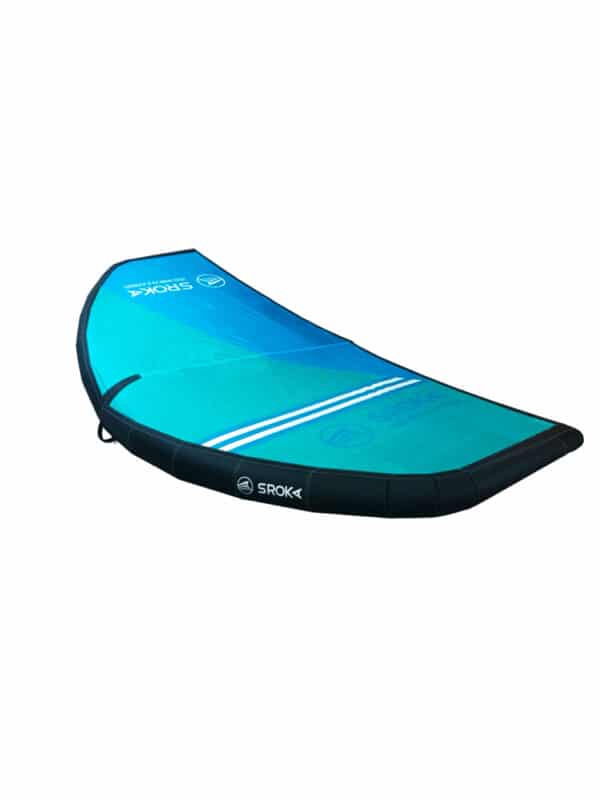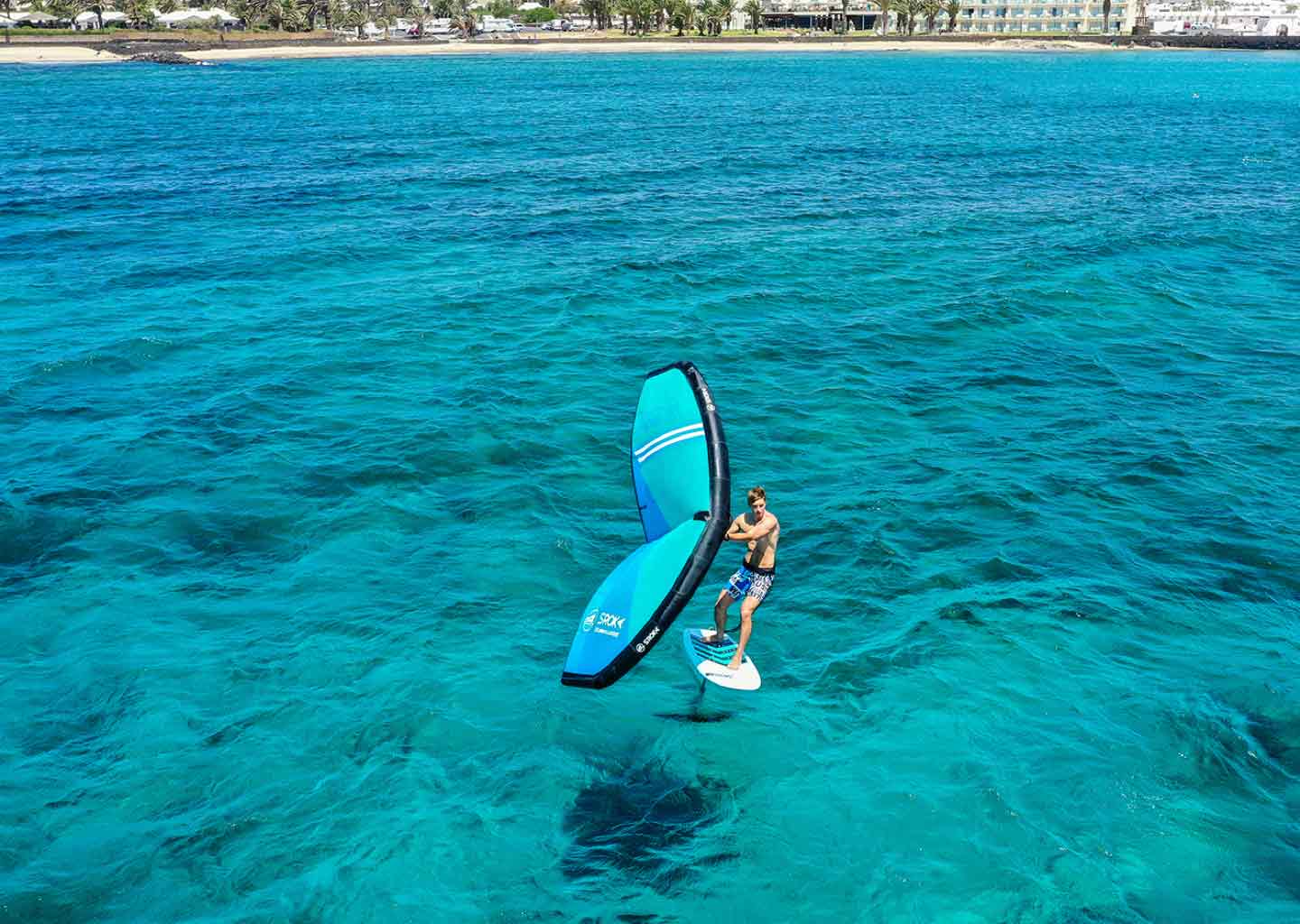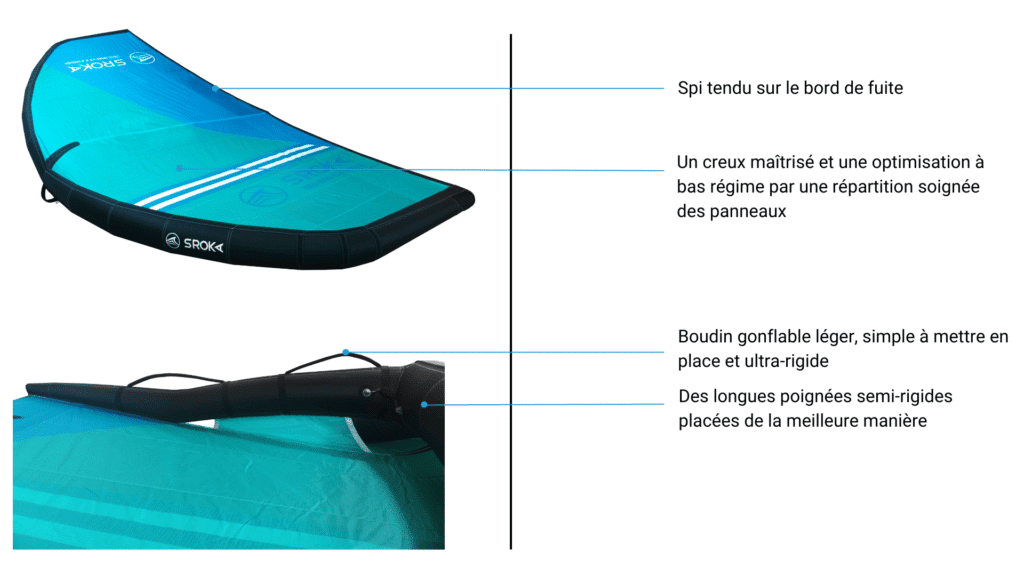Find below our wings for wing foiling as well as the adapted pump and backpack (bag included in the price of our Sroka V3 wing wing).


Wingfoil is a small revolution in board sports. With its wing, independent of the board, you will be able to move on snow, skateboard or water. Paired with a foil, you’ll be able to fly over the swell and surf swell trains. Wingfoil and the combination of several disciplines. The foil is similar to an “underwater” aircraft, generating hydrodynamic lift, allowing the rider to take off. The wing is the main engine of the wingfoil. So choosing a good wing is fundamental to make the most of all the conditions.
Not all wings are created equal. Some are very powerful, generate a lot of power but don’t accelerate. others are too soft, or with a very soft fall. In short, the wing wing is an engineering gem designed to harness the force of the wind and propel the rider above the water thanks to the foil under the board.
Designing a good kite is very complicated because unlike a foil where you can easily control the dimensions and profiles. A wing is made by assembling different materials with different flexibility, different rigidities that lead to tension in certain places or a modification of the profiles and therefore performance. So unfortunately, designing a really good wing requires time and a lot of prototyping.
The wing wings inflate to a specific pressure, ensuring optimal rigidity as well as a stable airfoil profile. This pressure depends on the materials used on the leading edge and the center batten. Equipped with rigid grips, these wings allow the rider to have maximum control of the sail and control the power more easily.
All our answers to the questions you may have when choosing your wing and wing size!

To put it simply, there are two types of shapes:
Boom construction is very rare. So rare, in fact, that only one brand offers it. Of course, you can place your hands freely in it, but it is non-bendable, bulky and heavier. Your transport comfort will suffer, especially if you are going on a trip. It’s also more dangerous in the event of a fall if you hit the boom head-on or hit your board deck with it.
If you’ve taken up wingsurfing partly to get rid of the old world of heavy and complicated rigging equipment, and you’re looking for a kite that can be forgotten in navigation as in a trunk, then the inflatable central batten is the right option. Before making your choice, you have to imagine that you will be sailing with your arms above your head for the whole session. After two hours, we are absolutely convinced that you will greatly appreciate having one kilo less to carry, lightness and ease of use.
Plus, you can’t imagine a simpler set up. One pump and you’re done. In less than two minutes, your wing is inflated and all that’s left is the launch between you and the pleasure of flying. And once the session is over, or if you have a sudden urge to travel, transportation is all the easier. All you need is one bag to fit the wing in any luggage or car trunk. It’s up to you to choose the best option, the one that suits your sailing style and your desires, but we sincerely believe that the choice of the inflatable is the one that best corresponds to the spirit of Wingsurf Foil, with its simplicity, the freedom it allows and its user friendly aspect never seen before in water sports.
Some brands continue to cover the center slat with handles. Others opt for sobriety, with a front handle and a rear handle. The right question to ask yourself in order to decide is: what do I have Oh, really need? If you want to fly gracefully in the light wind, have fun for hours in big conditions without being physically manhandled or have total freedom in surfing, you’re going to need a Wing light. The lighter the kite, the less it needs your help to self-support, and the freer you are to move.
Experience has also shown us that we always place our hands in the same places, regardless of the number of handles. So, why bother with weight, fragility points, and unnecessary handles that cause confusion? For all these reasons, we choose to have only what is really necessary on the wing: three comfortable, wide and solid handles . One for the front hand, one for the back hand and one for surfing located on the leading edge. Some of that weight gained, we reinvest in carefully placed reinforcements, so that it is actually useful and not just a selling point.
We also add two V-handles. They allow you to navigate with overpower or underpower, to have a freer hand placement and to always fall back on a support during manoeuvres. They tend to become more widespread.
If you want a wing that’s responsive, responsive, more capable, and capable of picking up the slightest gust of wind and turning it into movement power, a taut trailing edge is a must. For those for whom intense sailing at very high revs is the norm, we advise you to leave it a little slack to facilitate the flow, as you would do on a trimmed board sail. A sail that is too tight will quickly become unmanageable in gusts.
The distribution of the panels is crucial for maintaining the profile while sailing. If they are placed carefully, the drag will be greatly reduced and the wing much less physical. You’ll feel like you’re one with your equipment, which will increase your sense of pleasure tenfold.
To choose your dip, it all depends on what you need on your favorite spot. If it’s a super-powerful wing capable of making you start at a quarter turn, go for a big dip instead. On the other hand, it will saturate relatively quickly, lose stability at high revs and become very physical on the high range. If you’re looking to reach a higher top speed, opt for a flatter trough. Your kite will generate a little less power at low revs, but will accelerate endlessly like in a dream, while giving a much more pleasant sense of stability and control in the high range.
Windows in the sail would be handy on saturated spots… This is still far from being the case at the moment. It is also important to be aware that windows weigh down the wings and, depending on the quality of the materials used, can be a point of fragility. In case you opt for a windowless wing, it will require you to raise the sail to look downwind. So it’s up to you to choose according to your needs.


The size of the kite depends on the rider’s weight and wind conditions as well as their technical level. In other words, if a 55kg rider sails in 4m2, the 85kg rider sails with a 6m2 in the same conditions. It is recommended to opt for a quiver of at least 2 sails, to cover the largest possible range of use. The most commonly used quivers are 5 and 3.4 or 3.4 and 4.5 or 6 m and 4’5m depending on the size, weather conditions and preferences of each person. It is important to choose a quality wing, although at first glance all wings may seem similar but this is not the case.
Developing a good wing requires a lot of work. The SROKA wing V4 is the result of a constant search for excellence on the part of the Sroka team throughout the year. Customer feedback on the 3 previous versions and hundreds of prototypes makes it one of the most versatile sails on the market.
The maintenance of the wing is fundamental to keep your sail over time. Indeed, it is recommended to rinse your sail with fresh water after each session and to dry it in order to limit the wear and tear of it. If you can’t dry it completely, don’t rinse your kite. Also, do not store sails wet or full of sand.
Attach your wing properly when left on the beach to prevent it from flapping or flying off a foil and tearing.
There are many brands of wing on the market. You will say to me: they all look the same? From the outside, you will have a lot of difficulty to see the different ones. However, between the wingspan, the hollow of the wing, the fall tensions, the lightness, the solidity, the nervousness, the ability to accelerate, the ease of dumping… There are many differences that are visible from the outside but that will be felt enormously when sailing.
To sum up, there are two trends in the use of materials. On the leading edge of the wing, we use either Dacron to see good performance characteristics while maintaining a price accessible. Either we use alulla or dynema on the leading edge of the wing to gain raider and therefore pumping efficiency. We chose to use the Dynéma for the entire inflatable structure, which allows us to increase the pressures and maintain a lower tube size than the Dacron.
In the same way, the canopy uses different materials. There are differences in spinnaker quality. The thicker the spinnaker, the stiffer it will be and the more durable it will be over time. But it will be heavier. So you have to play on a famous mix between weight, rigidity, and durability.
In terms of performance. The profile is the first point that will determine the wingfoil performance. Some wings leave very early but quickly saturate with speed. Others are more geared towards going fast.
Our goal was to create a versatile wing that would allow you to combine a relatively early start but provide a nice feeling of speed. The V4 will be perfect for anyone looking for a good 4×4 wing. The V4 Elite will be designed for those who want to go for more performance by having a faster, thinner wing with less drag.
SROKA SHOP
62 rue de Penhoat – 29850 Gouesnou, France
Timetables
Monday to Friday
9:15 a.m. to 5:45 p.m.
